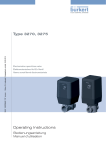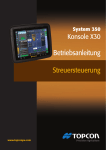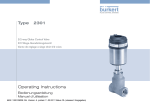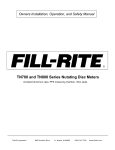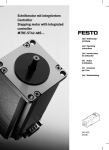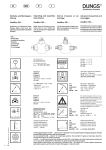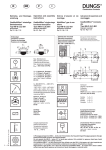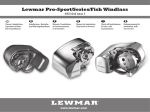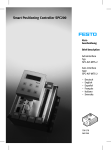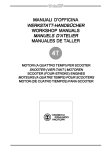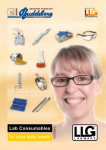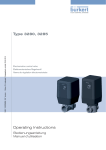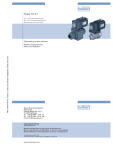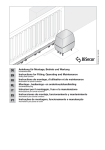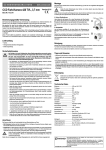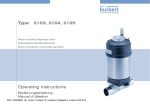Download Quickstart Type 3280, 3285 - Bürkert Fluid Control Systems
Transcript
Type 3280, 3285 Electromotive control valve Elektromotorisches Regelventil Vanne de régulation électromotorisée Quickstart We reserve the right to make technical changes without notice. Technische Änderungen vorbehalten. Sous réserve de modifications techniques. © 2015 Bürkert Werke GmbH Operating Instructions 1504/01_EU-ML_00810388 / Original DE Type 3280, 3285 Contents 7.4 7.5 Settings of DIP switches........................................................15 LED display................................................................................16 1 Quickstart...................................................................................................4 1.1 Definition of terms...................................................................... 4 1.2 Symbols........................................................................................ 4 8 2 Authorized use.......................................................................................5 2.1 Restrictions.................................................................................. 5 Start-up....................................................................................................... 17 8.1 Functions....................................................................................17 9 3 Basic safety instructions...........................................................5 4 General information.........................................................................6 4.1 Contact address......................................................................... 6 4.2 Warranty....................................................................................... 6 4.3 Information on the Internet....................................................... 6 Maintenance, troubleshooting.......................................... 18 9.1 Maintenance..............................................................................18 9.2 Cleaning.....................................................................................18 9.3 Troubleshooting........................................................................18 5 System description.............................................................................7 5.1 Intended use................................................................................ 7 5.2 Designs......................................................................................... 7 6 Technical data.........................................................................................9 6.1 Conformity.................................................................................... 9 6.2 Standards..................................................................................... 9 6.3 Operating conditions................................................................. 9 6.4 Mechanical data......................................................................... 9 6.5 Electrical data............................................................................10 6.6 Fluidic data................................................................................12 6.7 Type label...................................................................................12 7 Installation............................................................................................. 13 7.1 Safety instructions....................................................................13 7.2 Fluidic installation.....................................................................13 7.3 Electrical installation................................................................13 10 Transport, storage, disposal............................................... 20 english 3 Type 3280, 3285 Quickstart 1 Quickstart 1.2 The quickstart contains the most important information and notes regarding the use of the device. A detailed description of the device can be found in the operating instructions for Type 3280, 3285. Keep the quickstart in a location which is easily accessible to every user and make it available to every new owner of the device. Danger! Warns of an immediate danger. ▶▶ Failure to observe the warning may result in a fatal or serious injury. Warning! Important Safety Information. Read Quickstart carefully and thoroughly. Study in particular the chapters entitled “Basic safety instructions” and “Authorized use”. ▶▶ Quickstart must be read and understood. The operating instructions can be found on the Internet at: www.burkert.com 1.1 Definition of terms In these instructions the term “device” always refers to the electromotive control valve Type 3280 and 3285. Symbols Warns of a potentially dangerous situation. ▶▶ Failure to observe the warning may result in serious injuries or death. Caution! Warns of a possible danger. ▶▶ Failure to observe this warning may result in a moderate or minor injury. NOTE! Warns of damage to property. Important tips and recommendations. refers to information in these operating instructions or in other documentation. ▶▶ Designates an instruction to prevent risks. →→Designates a procedure which you must carry out. 4 english Type 3280, 3285 Authorized use 2 Authorized use Non-conforming use of the electromotive control valve Type 3280 and 3285 may be a hazard to people, nearby equipment and the environment. ▶▶ The electromotive control valve is designed to control the flow of non-aggressive, clean and non-corrosive liquid and gaseous medium. ▶▶ Do not use the device outdoors. ▶▶ Do not expose the valve to direct sunlight. ▶▶ Use Type 3280 and 3285 only in conjunction with third-party devices and components recommended and authorized by Bürkert. ▶▶ The device must be used in compliance with the characteristics and commissioning and use conditions specified in the contractual documents and in the user manual. ▶▶ Use the control valve only when in perfect condition and always ensure proper storage, transportation, installation and operation. ▶▶ Only use the device as intended. 2.1 Restrictions If exporting the device, observe any existing restrictions. 3 Basic safety instructions These safety instructions do not make allowance for any • contingencies and events which may arise during the assembly, operation, and maintenance. • local safety regulations – the operator is responsible for observing these regulations, also in relation to the installation personnel. Risk of injury from high pressure. ▶▶ Before loosening lines and valves, cut off the pressure and deaerate or drain lines. Risk of injury due to electrical shock. ▶▶ Before working on the system or device, switch off and isolate the power supply to prevent reactivation of the device. ▶▶ Observe applicable accident prevention and safety regulations for electrical equipment. Risk of burns and risk of fire if used for a prolonged duty cycle through hot device surface. ▶▶ Keep the device away from highly flammable substances and medium and do not touch with bare hands. General hazardous situations. To prevent injuries: ▶▶ Do not use Type 3280 and 3285 in potentially explosive areas. ▶▶ Do not subject the actuator housing and actuator cover to mechanical loading. english 5 Type 3280, 3285 General information ▶▶ Do not make any internal or external modifications on the device. Do not paint housing parts or screws. ▶▶ Avoid using the control valve in the vicinity of strong magnetic fields. ▶▶ Secure the device from unintentional actuation. ▶▶ Only trained technicians may perform installation and maintenance work. ▶▶ After an interruption in the power supply, ensure that the process is restarted in a defined or controlled manner. ▶▶ Observe the general rules of technology. 4 4.1 General information Contact address Germany Bürkert Fluid Control Systems Sales Center Christian-Bürkert-Str. 13-17 D-74653 Ingelfingen Tel. + 49 (0) 7940 - 10 91 111 Fax + 49 (0) 7940 - 10 91 448 E-mail: [email protected] Note! Electrostatic sensitive components and modules! International The device contains electronic components which react sensitively to electrostatic discharge (ESD). Contact with electrostatically charged persons or objects are hazardous to these components. In the worst case scenario, they will be destroyed immediately or will fail when energized. Contact addresses are found on the final pages of the printed operating manual. You can also find information on the Internet under: www.burkert.com • Observe the requirements in accordance with EN 61340-5-1 to minimize or avoid the possibility of damage caused by sudden electrostatic discharge! The warranty is only valid if the electromotive control valve Type 3280 and 3285 is used correctly in accordance with the specified operating conditions. • Do not touch electronic components while the supply voltage is switched on! 4.3 6 english 4.2 Warranty Information on the Internet The operating instructions and data sheets for Types 3280 and 3285 can be found on the Internet at: www.burkert.com Type 3280, 3285 System description 5 5.1 System description 5.2.1 Electromotive stroke valve Type 3280 Intended use The electromotive control valve Type 3280 and 3285 is designed to control the flow of non-aggressive, clean and non-corrosive liquid and gaseous medium. Only clean, liquid or gaseous medium, which does not react with the bodies and sealing materials, may be controlled. Threaded spindle Note! Valve spindle Unsuitable medium will damage the body and the seals! 5.2 Designs The following versions of the electromotive control valve are available: • electromotive 2/2-way stroke valve Type 3280 (DN2, DN3, DN4, DN6) - Control standard - Control positioner Elastomer seal Control cone • Use suitable medium only. • Check chemical compatibility in individual cases. Control electronics Linear stepper motor Body Fig. 1: Electromotive stroke valve Type 3280 5.2.2 Electromotive disk valve Type 3285 Control electronics Stepper motor with gearbox • electromotive 2/2-way disk valve Type 3285 (DN8, DN10, DN12, DN15, DN20, DN25) - Control standard - Control positioner Coupling Actuator shaft Spring Control wheel Fixed disc Body Fig. 2: Electromotive disc valve Type 3285 english 7 Type 3280, 3285 System description 5.2.3 Electric control The control valves 3280 and 3285 feature an electromotive actuator with an electric control. The device version is stated on the type label: 0 means standard, x means positioner. Control standard: Both valve end positions are indicated by the LED status. Additionally, the digital output indicates when the closed valve position has been achieved. Control positioner: Both valve end positions are indicated by the LED status. Moreover, the position actual value recorded using the position measuring system is output via the M12 circular plug-in connector. Z1 CMD Xd1 CTRL POS Valve opening + Position set-point value Position controller Electromotive actuator POS Position measuring system Position control circuit Fig. 3: 8 Signal flow diagram position controller english Continuous valve It is possible to communicate with the device digitally (e.g. for transferring the set-point or the actual value) via CANopen*- or büS**. * C ANopen - A CAN-based field bus (Controller Area Network) used in automation technology to link devices. ** büS - A CANopen-based field bus with additional functions. The positioner version also features some special functions, which can be set up using the Bürkert Communicator. The operating instructions for the Bürkert Communicator can be found at www.burkert.com. Type 3280, 3285 Technical data 6 6.1 Technical data Conformity The electromotive control valve Type 3280 and 3285 is compliant with EC directives as stated in the EC Declaration of Conformity. 6.2 Standards The applied standards, which are used to demonstrate compliance with the EC Directives, are listed in the EC type test certificate and/or the EC Declaration of Conformity. 6.3 Operating conditions Warning! Risk of injury due to malfunction if device used outdoors. ▶▶ Do not use the device outdoors and avoid heat sources which may cause the permitted temperature range to be exceeded. ▶▶ Protect the device from direct sunlight and humidity. Ambient temperature-10...+60 °C (observe derating curve, see chapter “6.5.1”) Medium temperature 0...+70 °C Medium temperature for oxygen 0...+60 °C Permitted air humidity < 95 %, non-condensing Medium non-aggressive, clean and non-corrosive liquid and gaseous medium which do not attack the bodies and sealing materials. Check resistance in individual cases (see chemical resistance chart at www.burkert.com). If medium is contaminated or contain particals, connect a suitable dirt filter upstream. 6.4 Mechanical data Connections Type 3280 G 1/4, G 3/8, NPT 1/4 or NPT 3/8 Type 3285G 1/2, G 3/4, G 1, NPT 1/2, NPT 3/4 or NPT 1 Weight Type 3280 ~0,7 kg (with VA body) Type 3285 DN8/10 ~0,8 kg (with VA body) DN12/15 ~1,2 kg (with VA body) DN20/25 ~1,5 kg (with VA body) Dimensions see data sheet english 9 Type 3280, 3285 Technical data 6.5 Electrical data Electrical data Control standard Control positioner Input impedance for analog input Control standard 60 Ω at 4...20 mA / resolution 40 µA 22 kΩ at 0...10 V / resolution 20 mV Control positioner 60 Ω at 0...20 mA and 4...20 mA / resolution 40 µA 22 kΩ at 0...5 V and 0...10 V / resolution 20 mV Connections Circular plug-in connector (M12 x 1, 8-pole) Operating voltage 24 V DC ±10 % 24 V DC ±10 % residual ripple < 10 % residual ripple < 10 % Power consumption Type 3280: max. 8 W Type 3280: max. 8 W Analog output (actual value output) - 0...20 mA, 4...20 mA, 0...5 V, 0...10 V (adjustable) Type 3285: max. 12 W Type 3285: max. 12 W Analog output - Standby power consumption approx. 1 W approx. 2 W Actuating time (0-100 %) Type 3280: approx. 2.5 s for setting “valve actuating speed normal” Type 3280: approx. 2.5 s for setting “valve actuating speed normal” max. current for voltage output 10 mA, max. load for current output 560 Ω Digital output - Type 3285: approx. 4 s for setting “valve actuating speed normal” Type 3285: approx. 4 s for setting “valve actuating speed normal” active, max. 100 mA current limitation, PNP, switching voltage = Usupply-1 V, short-circuit proof Limit switch contactless end position detection - 4...20 mA or 0...10 V (adjustable) 0...20 mA, 4...20 mA, 0...5 V or 0...10 V Analog input (Setpoint value input) 10 english Circular plug-in connector (M12 x 1, 8-polig) Electrical data Type 3280, 3285 Technical data Control standard Control positioner Position measuring system - non-contact, high resolution, and thus wear-free position measuring system Communication interface - büS or CANopen*) Duty cycle as per EN 60034-1: S3 50 %, depending on the operating conditions, observe derating curve 6.5.1 Derating The maximum duty cycle of the valve depends on the maximum ambient temperatures and the current required by the stepper motor. The derating curve can be used to indicate the maximum duty cycle permissible at the corresponding ambient temperature. By switching on the low power function a higher duty cycle can be achieved (Warning: during low power function, max medium pressure is reduced; if violated Valve will not move or malfunction). Setting options are described in the operating instruction under: www.burkert.com. as per EN 60034-1: S3 50 %, depending on the operating conditions, observe derating curve *) 3.3 V signal voltage, reliable communication decreases as the line length and transfer rate increases Duty cycle [%] Electrical data 100 90 80 70 60 50 40 30 20 10 Normal operation Energy save function 5 10 15 20 25 30 35 40 45 50 55 60 65 70 Max. ambient temperature [°C] Fig. 4: Derating curve english 11 Type 3280, 3285 Technical data 6.6 Fluidic data 12 Definition DN DN designates the orifice of the seat, not the orifice of the port connection. 3280 Ori- fice 2 3 4 6 3285 8 10 Port KVs-value Max. pressure connec- [m³/h] for flammable *) gases [bar] tion Max. pressure [bar] 20 25 G 1/4 0.15 3 6 NPT 1/4 0.15 3 6 G 1/4 0.3 3 6 NPT 1/4 0.3 3 6 G 3/8 0.5 3 6 NPT 3/8 0.5 3 6 G 3/8 0.9 3 6 NPT 3/8 0.9 3 6 G 1/2 1.8 3 6 NPT 1/2 1.8 3 6 G 1/2 2.5 3 6 NPT 1/2 2.5 3 3.9 3 6 NPT 3/4 3.9 3 6 G 3/4 6.0 3 6 NPT 3/4 6.0 3 6 G1 8.8 3 6 NPT 1 8.8 3 6 G1 12.3 3 6 NPT 1 12.3 3 6 The KVs value is a flow rate value for water, measurement at +20 °C and 1 bar pressure difference above the fully opened valve *) 6.7 Type label Nominal diameter Sealing material Electronic valve version Body material Type D-74653 Ingelfingen Type 15 G 3/4 6 3280 X DN25 EPDM MS NPT 1/4 PN 6 bar 24 V DC 8 W Tamb see manual 268611 SN000000 W3ZLT Identity number, Serial number Ambient temperature Fig. 5: 12 english Description of the type label (example) Port connection, Pressure range Voltage, Max. power consumption Type 3280, 3285 Installation 7 7.1 Installation Safety instructions Warning! Risk of injury from improper installation. ▶▶ Installation may be carried out only by trained technicians and with the appropriate tools! ▶▶ Secure system against unintentional activation. ▶▶ Following installation, ensure a controlled or defined restart. 7.2 →→Hold the device with a suitable tool (open-end wrench) on the body and screw into the pipeline. →→Observe flow direction. The arrow on the body indicates the direction of flow. Type 3280: Flow direction below seat, is always closed against the medium flow; Type 3285: Flow direction above seat, is always closed with the medium flow. Fluidic installation Danger! Risk of injury from high pressure in the system or device. ▶▶ Before working on the system or device, cut off the pressure and deaerate/drain lines. Installation position: any position, preferably with actuator above and installed vertically with the actuator cover upwards →→Clean pipelines and port connections. →→Install a dirt filter before the valve inlet (≤ 0.3 mm). Note! Caution risk of breakage! • Do not use plastic actuator housing as a lever arm. Fig. 6: 7.3 Direction of flow Type 3280, Flow direction below seat Fig. 7: Direction of flow Type 3285, Flow direction above seat Electrical installation Danger! Risk of injury due to electrical shock. ▶▶ Before working on the system or device, switch off and isolate the power supply to prevent reactivation of the device. ▶▶ Observe applicable accident prevention and safety regulations for electrical equipment. english 13 Type 3280, 3285 Installation None of the electrical inputs and outputs of the device are galvanically isolated from the supply voltage. Pin assignment for the standard version: Note! Damage to the electromotive control valve due to incorrect supply voltage! • The supply voltage must correspond with the voltage indicated on the type label. • If the ground connection is not connected, the conditions of the EMC Law will not be met. →→Connect the electromotive control valve according to the table. When the supply voltage is applied, the electromotive control valve is ready for operation. Pin Configuration External circuit 1 Supply + 24 V DC ±10 %, max. residual ripple 10 % 2 Supply GND 24 V DC GND 3 do not connect! Electrically insulate wire on connection line 4 do not connect! Electrically insulate wire on connection line 5 do not connect! Electrically insulate wire on connection line 6 Set-point value input + 4...20 mA / 0...10 V, not galvanically isolated 7 Binary output 0...5 V (log. 0), 10...30 V (log. 1), not galvanically isolated Signal GND Signal GND Shielding - Designation of the circular connector (M12 x 1, 8-pole): 8 Body * 3 4 2 5 *) 8 6 1 7 Fig. 8: 14 Circular connector M12 x 1, 8-pole english ) he threaded sleeve of the M12 circular connector is connected to the valve T body. Connect the body to a suitable ground connection. To ensure electromagnetic compatibility (EMC), ensure that the cable is as short as possible and the cross-section is as large as possible. Type 3280, 3285 Installation 7.4 Pin assignment for the positioner version: Pin Configuration External circuit 1 Supply + 24 V DC ±10 %, max. residual ripple 10 % 2 Supply GND 24 V DC GND 3 CAN low CAN low**) 4 CAN high CAN high**) 5 CAN GND CAN GND**) 6 Set-point value input + 0...20 mA / 4...20 mA / 0...5 V / 0...10 V, not galvanically isolated 7 Actual value output 0....20 mA / 4...20 mA / 0...5 V / 0...10 V, not galvanically isolated Signal GND Signal GND Shielding - 8 Body * *) **) ) he threaded sleeve of the M12 circular connector is connected to the valve T body. Connect the body to a suitable ground connection. To ensure electromagnetic compatibility (EMC), ensure that the cable is as short as possible and the cross-section is as large as possible. .3 V signal voltage, reliable communication decreases as the line length 3 and transfer rate increases. Settings of DIP switches Danger! Risk of injury due to electrical shock. ▶▶ Before opening the actuator cover, switch off and isolate the power supply to prevent reactivation of the device. ▶▶ Observe applicable accident prevention and safety regulations for electrical equipment. The DIP switches are accessible on the electronic PCB by opening the actuator cover. On 1 Fig. 9: 2 3 4 Settings of DIP switches for Type 3280 and 3285 Further adjustments can be made. Setting options are described in the operating instruction. english 15 Type 3280, 3285 Installation Description of the function: DIP switch Position 1 OFF 3 4 16 Positioner version Normal operating direction of the set-point value (e.g. set-point value 4...20 mA corresponds to position 0...100 %), increasing no function Reversal of the operating direction of the set-point value (e.g. set-point value 20...4 mA corresponds to position 0...100 %), decreasing no function OFF Set-point value input 4...20 mA Set-point value source analog input ON Set-point value input 0...10 V Set-point value source field bus (büS or CANopen) OFF Valve actuating speed: normal mode büS ON Valve actuating speed: slow mode CANopen OFF Low power function: off no function ON Low power function: on, lower force, less heat generation in the valve no function ON 2 Standard version english The change in function does not become effective until the supply voltage is applied again. A more precise description of the functions can be found in operating instructions. 7.5 LED display With the aid of the positioner version, it is possible to use the Bürkert Communicator Software to toggle the LED colors between standard and NAMUR NE 107. 7.5.1 Display elements standard LED color Status Display white continuously on Normal operation white flashing Booting phase when voltage applied yellow continuously on Valve completely open green continuously on Valve closed red flashing Error white, green flashing or red Is used to identify a device in the büS network. The „flashing“ status is started in the Bürkert Communicator Software when selecting the device no color or LED off Valve without power supply - Type 3280, 3285 Start-up 7.5.2 Display elements NAMUR NE 107 LED color Status Display white continuously on Normal operation green continuously on Active diagnosis red continuously on Error white, green flashing or red no color or LED off - Is used to identify a device in the büS network. The „flashing“ status is started in the Bürkert Communicator Software when selecting the device Valve without power supply 8 Start-up Warning! Danger due to improper operation. ▶▶ Observe the safety instructions and intended use. ▶▶ Only adequately trained personnel may operate the device. Before start-up, carry out fluid and electrical installation of the valve. 8.1 Functions Electromotive control valve Type 3280 and 3285 has different functions which can be configured and parametrized via the DIP switches and communications software. A more precise description of the functions can be found in operating instructions under: www.burkert.com. english 17 Type 3280, 3285 Maintenance, troubleshooting 9 Maintenance, troubleshooting 9.3 Danger! • the port connectors, Risk of injury from high pressure in the system or device. ▶▶ Before working on the system or device, cut off the pressure and deaerate or drain lines. Risk of injury due to electrical shock. ▶▶ Before working on the system or device, switch off and isolate the power supply to prevent reactivation of the device. ▶▶ Observe applicable accident prevention and safety regulations for electrical equipment. Warning! Risk of injury from improper maintenance work. ▶▶ Maintenance may be carried out only by trained technicians and with the appropriate tools. ▶▶ Secure system against unintentional activation. ▶▶ Following maintenance, ensure a controlled restart. 9.1 Maintenance The electromotive control valve Type 3280 and 3285 is maintenancefree under normal conditions. 9.2 Cleaning Use the normal cleaning agents to clean the Type 3280 and 3285. Use no alkaline cleansing agents, as these have a damaging effect on the materials used. 18 english Troubleshooting In malfunctions occur, check: • whether the operating pressure is within the permitted range, • the power supply and the standard signals. Type 3280, 3285 Maintenance, troubleshooting Problem LED is not lit LED flashes sporadically white Possible cause No power supply The power supply collapses periodically device software reboots each time LED flashes red or LED illuminates red The residual ripple of the supply voltage is too high Remedial action →→Check the electrical connections →→Select power supply with adequate power →→Check cable for possible lose connections →→Use power supply with a smooth output voltage at the required power →→After eliminating the fault, restart the device for normal operating (isolate from power supply) Temperature too high →→Observe max. ambient temperature / medium temperature; if required reduce duty cycle (see Derating curve) →→After eliminating the fault, restart the device for normal operating (isolate from power supply) Standard signal is < 4 mA; cable break →→Check cable for possible lose connections No flow rate available Valve opens even though it should close Motor is making an unusual droning noise Valve is not opening or closing correctly The set-point value is below the limit for the zero point shut-off Operating direction of the set-point value has been set incorrectly →→Increase set-point value Gearbox or motor blocked →→Return device to the manufacturer to have the fault repaired Low power function activated; motor torque for medium pressure too low →→Deactivate low power function Valve is not sealed Dirt between seal and valve seat →→Install dirt filter and return device to the manufacturer for cleaning →→Change direction of the set-point english 19 Type 3280, 3285 Transport, storage, disposal 10 Transport, storage, disposal Note! Transport damage. Inadequately protected devices may be damaged during transportation. • Protect the device against moisture and dirt in shock-resistant packaging during transportation. • Prevent the temperature from exceeding or dropping below the permitted storage temperature. • Using protective caps, protect the electrical interfaces from damage. Incorrect storage may damage the device. • Store the device in a dry and dust-free location! • Storage temperature: -20 °C...+70 °C. Damage to the environment caused by parts contaminated with medium. • Dispose of the device and packaging in an environmentally friendly manner. • Observe applicable disposal and environmental regulations. Observe the national waste disposal regulations. 20 english Typ 3280, 3285 Inhaltsverzeichnis 7.4 7.5 DIP-Schalter Einstellungen....................................................33 LED-Anzeige.............................................................................34 1 Der Quickstart..................................................................................... 22 1.1 Begriffsdefinition Gerät...........................................................22 1.2 Darstellungsmittel.....................................................................22 8 2 BestimmungsgemäSSer Gebrauch2����������������������������������� 23 2.1 Beschränkungen.......................................................................23 Inbetriebnahme.................................................................................... 35 8.1 Funktionen..................................................................................35 9 3 Grundlegende Sicherheitshinweise............................... 23 4 Allgemeine Hinweise........................................................................ 24 4.1 Kontaktadressen.......................................................................24 4.2 Gewährleistung.........................................................................24 4.3 Informationen im Internet........................................................24 Wartung, Fehlerbehebung....................................................... 36 9.1 Wartungsarbeiten.....................................................................36 9.2 Reinigung...................................................................................36 9.3 Störungen..................................................................................36 5 Systembeschreibung..................................................................... 25 5.1 Vorgesehener Einsatzbereich................................................25 5.2 Ausführungen............................................................................25 6 Technische Daten.............................................................................. 27 6.1 Konformität.................................................................................27 6.2 Normen.......................................................................................27 6.3 Betriebsbedingungen..............................................................27 6.4 Mechanische Daten.................................................................27 6.5 Elektrische Daten.....................................................................28 6.6 Fluidische Daten.......................................................................30 6.7 Typschild.....................................................................................30 7 Installation............................................................................................. 31 7.1 Sicherheitshinweise.................................................................31 7.2 Fluidische Installation..............................................................31 7.3 Elektrische Installation.............................................................31 10 Transport, Lagerung, Entsorgung.................................. 38 deutsch 21 Typ 3280, 3285 Der Quickstart 1 Der Quickstart 1.2 Der Quickstart enthält in Kurzform die wichtigsten Informationen und Hinweise für den Gebrauch des Geräts. Die ausführliche Beschreibung finden Sie in der Bedienungsanleitung für den Typ 3280, 3285. Bewahren Sie den Quickstart so auf, dass er für jeden Benutzer gut zugänglich ist und jedem neuen Eigentümer des Geräts wieder zur Verfügung steht. Wichtige Informationen zur Sicherheit. Lesen Sie den Quickstart sorgfältig durch. Beachten Sie vor allem die Kapitel „Grundlegende Sicherheitshinweise“ und „Bestimmungsgemäßer Gebrauch“. ▶▶ Der Quickstart muss gelesen und verstanden werden. Die Bedienungsanleitung finden Sie im Internet unter: www.buerkert.de 1.1 Begriffsdefinition Gerät Darstellungsmittel In dieser Anleitung werden folgende Darstellungsmittel verwendet. Gefahr! Warnt vor einer unmittelbaren Gefahr! ▶▶ Bei Nichtbeachtung sind Tod oder schwere Verletzungen die Folge. Warnung! Warnt vor einer möglicherweise gefährlichen Situation! ▶▶ Bei Nichtbeachtung drohen schwere Verletzungen oder Tod. Vorsicht! Warnt vor einer möglichen Gefährdung! ▶▶ Nichtbeachtung kann mittelschwere oder leichte Verletzungen zur Folge haben. Hinweis! Der in dieser Anleitung verwendeten Begriff „Gerät“ steht immer für das Regelventil Typ 3280 und 3285. Warnt vor Sachschäden! Wichtige Tipps und Empfehlungen. verweist auf Informationen in dieser Bedienungsanleitung oder in anderen Dokumentationen. ▶▶ markiert eine Anweisung zur Gefahrenvermeidung. →→markiert einen Arbeitsschritt den Sie ausführen müssen. 22 deutsch Typ 3280, 3285 Bestimmungsgemäßer Gebrauch 2 BestimmungsgemäSSer Gebrauch Bei nicht bestimmungsgemäßem Einsatz des elektromotorischen Regelventils Typ 3280, 3285 können Gefahren für Personen, Anlagen in der Umgebung und die Umwelt entstehen. ▶▶ Das elektromotorische Regelventil ist für die Steuerung von nicht aggressiven, reinen und nicht korrosiven flüssigen und gasförmigen Medien konzipiert. ▶▶ Für den Einsatz die in den Vertragsdokumenten und der Bedienungsanleitung spezifizierten zulässigen Daten, Betriebs- und Einsatzbedingungen beachten. ▶▶ Das Gerät nicht im Außenbereich einsetzen. ▶▶ Das Ventil nicht der direkten Sonneneinstrahlung aussetzen. ▶▶ Der Typ 3280, 3285 nur in Verbindung mit von Bürkert empfohlenen bzw. zugelassenen Fremdgeräten und -komponenten einsetzen. ▶▶ Für den Einsatz die in den Vertragsdokumenten und der Bedienungsanleitung spezifizierten zulässigen Daten, Betriebs- und Einsatzbedingungen beachten. ▶▶ Das Regelventil nur in einwandfreiem Zustand betreiben und auf sachgerechte Lagerung, Transport, Installation und Bedienung achten. ▶▶ Das Gerät nur bestimmungsgemäß einsetzen. 2.1 Beschränkungen Beachten Sie bei der Ausfuhr des Geräts gegebenenfalls bestehende Beschränkungen. 3 Grundlegende Sicherheitshinweise Diese Sicherheitshinweise berücksichtigen keine • Zufälligkeiten und Ereignisse, die bei Montage, Betrieb und Wartung auftreten können. • ortsbezogenen Sicherheitsbestimmungen, für deren Einhaltung, auch in Bezug auf das Montagepersonal, der Betreiber verantwortlich ist. Verletzungsgefahr durch hohen Druck. ▶▶ Vor dem Lösen von Leitungen und Ventilen den Druck abschalten und Leitungen entlüften. Verletzungsgefahr durch Stromschlag. ▶▶ Vor Arbeiten an Anlage oder Gerät, die Spannung abschalten und vor Wiedereinschalten sichern. ▶▶ Die geltenden Unfallverhütungs- und Sicherheitsbestimmungen für elektrische Geräte beachten. Verbrennungsgefahr oder Brandgefahr bei längerer Einschaltzeit durch heiße Geräteoberfläche. ▶▶ Das Gerät von leicht brennbaren Stoffen und Medien fernhalten und nicht mit bloßen Händen berühren. Allgemeine Gefahrensituationen. Zum Schutz vor Verletzungen ist zu beachten: ▶▶ Der Typ 3280, 3285 nicht in explosionsgefährdeten Bereichen einsetzen. ▶▶ Gehäuse nicht mechanisch belasten. deutsch 23 Typ 3280, 3285 Allgemeine Hinweise ▶▶ Am Gerät keine inneren oder äußeren Veränderungen vornehmen. Gehäuseteile und Schrauben nicht lackieren. ▶▶ Den Einsatz des Regelventils im Umfeld von starken Magnetfeldern vermeiden. ▶▶ Vor unbeabsichtigter Betätigung sichern. ▶▶ Nur geschultes Fachpersonal darf Installations- und Instandhaltungsarbeiten ausführen. ▶▶ Nach Unterbrechung der elektrischen Versorgung für einen kontrollierten Wiederanlauf des Prozesses sorgen. ▶▶ Die allgemeinen Regeln der Technik einhalten. 4 4.1 Allgemeine Hinweise Kontaktadressen Deutschland Bürkert Fluid Control Systems Sales Center Christian-Bürkert-Str. 13-17 D-74653 Ingelfingen Tel. + 49 (0) 7940 - 10 91 111 Fax + 49 (0) 7940 - 10 91 448 E-mail: [email protected] Hinweis! Elektrostatisch gefährdete Bauelemente oder Baugruppen! International Das Gerät enthält elektronische Bauelemente, die gegen elektrostatische Entladung (ESD) empfindlich reagieren. Berührung mit elektrostatisch aufgeladenen Personen oder Gegenständen gefährdet diese Bauelemente. Im schlimmsten Fall werden sie sofort zerstört oder fallen nach der Inbetriebnahme aus. Die Kontaktadressen finden Sie auf den letzten Seiten der gedruckten Bedienungsanleitung. • Die Anforderungen nach EN 61340-5-1 beachten, um die Möglichkeit eines Schadens durch schlagartige elektrostatische Entladung zu minimieren bzw. zu vermeiden. • Elektronische Bauelemente nicht bei anliegender Versorgungsspannung berühren. Außerdem im Internet unter: www.burkert.com 4.2 Gewährleistung Voraussetzung für die Gewährleistung ist der bestimmungsgemäße Gebrauch des elektromotorischen Regelventils Typ 3280, 3285 unter Beachtung der spezifizierten Einsatzbedingungen. 4.3 Informationen im Internet Bedienungsanleitungen und Datenblätter zum Typ 3280, 3285 finden Sie im Internet unter: www.buerkert.de 24 deutsch Typ 3280, 3285 Systembeschreibung 5 5.1 Systembeschreibung 5.2.1 Elektromotorisches Hubventil Typ 3280 Vorgesehener Einsatzbereich Das elektromotorische Regelventil Typ 3280 und 3285 ist für die Steuerung von nicht aggressiven, reinen und nicht korrosiven flüssigen und gasförmigen Medien konzipiert. Es dürfen nur saubere, flüssige oder gasförmige Medien gesteuert werden, die Gehäuse und Dichtwerkstoffe nicht angreifen. Linear-Schrittmotor Gewindespindel Ventilspindel Hinweis! Regelkegel Beschädigung des Gehäuses und der Dichtungen durch ungeeignete Medien. • Nur geeignete Medien verwenden. • Die Beständigkeit im Einzelfall prüfen. 5.2 Ausführungen Bild 1: Elastomerdichtung Gehäuse Elektromotorisches Hubventil Typ 3280 5.2.2 Elektromotorisches Scheibenventil Typ 3285 Das elektromotorische Regelventil gibt es in folgenden Ausführungen: • elektromotorisches 2/2-Wege-Hubventil Typ 3280 (DN2, DN3, DN4, DN6) - Ansteuerung Standard - Ansteuerung Positioner Ansteuerelektronik Schrittmotor mit Getriebe • elektromotorisches 2/2-Wege-Scheibenventil Typ 3285 (DN8, DN10, DN12, DN15, DN20, DN25) - Ansteuerung Standard - Ansteuerung Positioner Feder Fixscheibe Ansteuerelektronik Kupplung Antriebswelle Regelscheibe Gehäuse Bild 2: Elektromotorisches Scheibenventil Typ 3285 deutsch 25 Typ 3280, 3285 Systembeschreibung 5.2.3 Elektrische Ansteuerung Die Regelventile des Typs 3280 und 3285 enthalten einen elektromotorischen Antrieb mit elektrischer Ansteuerung. Die Ausführung des Geräts ist auf dem Typschild zu erkennen: 0 bedeutet Standard, x steht für Positioner. Ansteuerung Standard: Die beiden Endlagen des Ventils werden über die LED-Status signalisiert. Das Erreichen der Ventilstellung geschlossen wird über den Digitalausgang ausgegeben. Ansteuerung Positioner: Die beiden Endlagen des Ventils werden über die LED-Status signalisiert. Zusätzlich wird der über das Wegmesssystem erfasste StellungsIstwert über den Rundsteckverbinder M12 ausgegeben. Z1 CMD StellungsSollwert Xd1 CTRL POS + Stellungsregler Elektromotorischer Antrieb Ventilöffnung Stetigventil POS Wegmesssystem Stellungsregelkreis Bild 3: 26 Signalflussplan Stellungsregler deutsch Es besteht die Möglichkeit mit dem Gerät digital (z. B. zum Übertragen des Soll- oder Istwerts) über CANopen*- oder büS** zu kommunizieren. * C ANopen - Ein auf CAN (Controller Area Network) basierender Feldbus, der in der Automatisierungstechnik zur Vernetzung von Geräten eingesetzt wird. ** büS - Ein auf CANopen basierender Feldbus mit zusätzlichen Funktionalitäten. Die Positionerausführung verfügt außerdem über einige Sonderfunktion, die mithilfe des Bürkert-Communicators eingestellt werden können. Bedienungsanleitung zu Bürkert-Communicator finden sie unter www.buerkert.de. Typ 3280, 3285 Technische Daten 6 6.1 Technische Daten Konformität Das elektromotorische Regelventil Typ 3280, 3285 ist konform zu den EG-Richtlinien entsprechend der EG-Konformitätserklärung. 6.2 Normen Medien nicht aggressive, reine und nicht korrosive flüssige und gasförmige Medien, die Gehäuse und Dichtwerkstoffe nicht angreifen. Beständigkeit im Einzelfall prüfen (Beständigkeitstabelle auf www.burkert.de). Bei verschmutzen Medien einen geeigneten Schmutzfilter vorschalten. Die angewandten Normen, mit welchen die Konformität zu den Richtlinien nachgewiesen wird, sind in der EG-Baumusterprüfbescheinigung und/oder der EG-Konformitätserklärung nachzulesen. 6.4 6.3 Typ 3280 Betriebsbedingungen Mechanische Daten Anschlüsse G 1/4, G 3/8, NPT 1/4 oder NPT 3/8 Typ 3285G 1/2, G 3/4, G 1, NPT 1/2, NPT 3/4 oder NPT 1 Warnung! Verletzungsgefahr durch Funktionsausfall bei Einsatz im Außenbereich. ▶▶ Das Gerät nicht im Außenbereich einsetzen und Wärmequellen, die zur Überschreitung des zulässigen Temperaturbereichs führen können, vermeiden. ▶▶ Das Gerät vor direkter Sonneneinstrahlung schützen. Umgebungstemperatur-10...+60 °C (Derating-Kurve beachten, siehe Kapitel „6.5.1“) Mediumstemperatur 0...+70 °C Mediumstemperatur bei Sauerstoff 0...+60 °C Zulässige Luftfeuchtigkeit < 95 %, nicht kondensierend Gewicht Typ 3280 ~0,7 kg (mit VA-Gehäuse) Typ 3285 DN8/10 ~0,8 kg (mit VA-Gehäuse) DN12/15 ~1,2 kg (mit VA-Gehäuse) DN20/25 ~1,5 kg (mit VA-Gehäuse) Abmessungen deutsch siehe Datenblatt 27 Typ 3280, 3285 Technische Daten 6.5 Elektrische Daten Elektrische Daten Ansteuerung Standard Ansteuerung Positioner Anschlüsse Rundsteckverbinder (M12 x 1, 8-polig) Rundsteckverbinder (M12 x 1, 8-polig) Betriebsspannung 24 V DC ±10 % 24 V DC ±10 % Restwelligkeit < 10 % Restwelligkeit < 10 % Leistungsaufnahme Typ 3280: max. 8 W Typ 3280: max. 8 W Typ 3285: max. 12 W Typ 3285: max. 12 W Standby-Stromverbrauch ca. 1 W ca. 2 W Stellzeit (0-100 %) Typ 3280: ca. 2,5 s bei Einstellung „Ventilgeschwindigkeit normal“ Typ 3280: ca. 2,5 s bei Einstellung „Ventilgeschwindigkeit normal“ Typ 3285: ca. 4 s bei Einstellung „Ventilgeschwindigkeit normal“ Typ 3285: ca. 4 s bei Einstellung „Ventilgeschwindigkeit normal“ 4...20 mA oder 0...10 V (einstellbar) 0...20 mA, 4...20 mA, 0...5 V oder 0...10 V Analogeingang (Sollwerteingang) 28 deutsch Elektrische Daten Eingangsimpedanz für Analogeingang Ansteuerung Standard 60 Ω bei 4...20 mA / Auflösung 40 µA 22 kΩ bei 0...10 V / Auflösung 20 mV Ansteuerung Positioner 60 Ω bei 0...20 mA und 4...20 mA / Auflösung 40 µA 22 kΩ bei 0...5 V und 0...10 V / Auflösung 20 mV Analogausgang (Istwertausgang) - 0...20 mA, 4...20 mA, 0...5 V, 0...10 V (einstellbar) Analogausgang - max. Strom für Spannungsausgang 10 mA, max. Bürde für Stromausgang 560 Ω Digitalausgang aktiv, max. 100 mA Strombegrenzung, PNP, Schaltspannung = Uvers-1 V, kurzschlussfest - Endschalter berührungslose Endlagenerfassung - Typ 3280, 3285 Technische Daten Ansteuerung Standard Ansteuerung Positioner Wegmesssystem - Berührungsloses, hochauflösendes und damit verschleißfreies Wegmesssystem Kommunikationsschnittstelle - büS oder CANopen*) Einschaltdauer nach EN 60034-1: S3 50 %, abhängig von den Einsatzbedingungen. Derating-Kurve beachten nach EN 60034-1: S3 50 %, abhängig von den Einsatzbedingungen. Derating-Kurve beachten *) 3,3 V Signalspannung, die sichere Kommunikation nimmt zunehmender Leitungslänge und Übertragungsrate ab 6.5.1 Derating Die maximale Einschaltdauer des Ventils ist abhängig von den maximalen Umgebungstemperaturen und dem Spulenstroms des Schrittmotors. Aus der Derating-Kurve kann abgelesen werden, welche maximale Einschaltdauer bei welcher maximalen Umgebungstemperatur zulässig ist. Mit eingeschalteter Energiesparfunktion kann eine höhere Einschaltdauer gewählt werden. Einstellmöglichkeiten sind in der Bedienungsanleitung beschrieben unter: www.buerkert.de. Einschaltdauer [%] Elektrische Daten 100 90 80 70 60 50 40 30 20 10 Normalbetrieb Energiesparfunktion 5 10 15 20 25 30 35 40 45 50 55 60 65 70 max. Umgebungstemperatur [°C] Bild 4: Derating-Kurve deutsch 29 Typ 3280, 3285 Technische Daten 6.6 Fluidische Daten 12 Definition DN DN bezeichnet die Nennweite des Sitzes, nicht die Nennweite des Leitungsanschlusses. 3280 Nennweite 2 3 4 6 3285 8 10 Lei- KVs-Wert tungs- [m³/h] *) anschluss Max. Druck bei brennbaren Gasen [bar] Max. Druck [bar] 20 25 G 1/4 0,15 3 6 NPT 1/4 0,15 3 6 G 1/4 0,3 3 6 NPT 1/4 0,3 3 6 G 3/8 0,5 3 6 NPT 3/8 0,5 3 6 G 3/8 0,9 3 6 NPT 3/8 0,9 3 6 G 1/2 1,8 3 6 NPT 1/2 1,8 3 6 G 1/2 2,5 3 6 NPT 1/2 2,5 3 3,9 3 6 NPT 3/4 3,9 3 6 G 3/4 6,0 3 6 NPT 3/4 6,0 3 6 G1 8,8 3 6 NPT 1 8,8 3 6 G1 12,3 3 6 NPT 1 12,3 3 6 Der KVs-Wert ist ein Durchflusswert für Wasser, Messung bei +20 °C und 1 bar Druckdifferenz über dem voll geöffneten Ventil. *) 6.7 Typschild Nennweite Dichtungswerkstoff Elektronische Ausführung des Ventils Typ D-74653 Ingelfingen Typ 15 G 3/4 6 Gehäusewerkstoff 3280 X DN25 EPDM MS NPT 1/4 PN 6 bar 24 V DC 8 W Tamb see manual 268611 SN000000 W3ZLT Identnummer, Seriennummer Umgebungstemperatur Bild 5: 30 deutsch Beschreibung des Typschilds (Beispiel) Leitungsanschluss, Druckbereich Spannung, Max. Leistungsaufnahme Typ 3280, 3285 Installation 7 7.1 Installation Sicherheitshinweise Warnung! Verletzungsgefahr bei unsachgemäßer Installation. ▶▶ Die Installation darf nur geschultes Fachpersonal mit geeignetem Werkzeug durchführen. ▶▶ Anlage vor unbeabsichtigtem Betätigen sichern. ▶▶ Nach der Installation einen kontrollierten Wiederanlauf gewährleisten. 7.2 →→Das Gerät mit geeignetem Werkzeug (Gabelschlüssel) am Gehäuse festhalten und in die Rohrleitung einschrauben. →→Durchflussrichtung beachten. Der Pfeil auf dem Gehäuse kennzeichnet die Durchflussrichtung. Typ 3280: Anströmung unter Sitz, wird immer gegen den Mediumstrom geschlossen; Typ 3285: Anströmung über Sitz, wird immer mit dem Mediumstrom geschlossen. Fluidische Installation GEFAHR! Verletzungsgefahr durch hohen Druck in Anlage oder Gerät. ▶▶ Vor Arbeiten an Anlage oder Gerät, den Druck abschalten und Leitungen entlüften oder entleeren. Einbaulage: beliebig, vorzugsweise Antrieb oben und bei vertikaler Einbaulage Antriebsdeckel nach oben →→Rohrleitungen und Flanschanschlüsse säubern. →→Vor dem Ventileingang einen Schmutzfilter einbauen (≤ 0,3 mm). Hinweis! Vorsicht Bruchgefahr! • Antriebsgehäuse aus Kunststoff nicht als Hebelarm benutzen. Bild 6: 7.3 Durchflussrichtung Typ 3280, Anströmung unter Sitz Bild 7: Durchflussrichtung Typ 3285, Anströmung über Sitz Elektrische Installation GEFAHR! Verletzungsgefahr durch Stromschlag. ▶▶ Vor Arbeiten an Anlage oder Gerät, die Spannung abschalten und vor Wiedereinschalten sichern. ▶▶ Die geltenden Unfallverhütungs- und Sicherheitsbestimmungen für elektrische Geräte beachten. deutsch 31 Typ 3280, 3285 Installation Alle elektrischen Eingänge und Ausgänge des Geräts sind zur Versorgungsspannung nicht galvanisch getrennt. Pin-Belegung für Standardausführung: Pin Belegung Äußere Beschaltung 1 Versorgung + 24 V DC ±10 %, max. Restwelligkeit 10 % Beschädigung des Geräts durch falsche Versorgungsspannung. 2 Versorgung GND 24 V DC GND • Versorgungsspannung muss dem auf dem Typschild angegebenen Spannung entsprechen. 3 nicht belegen! • Bei nicht angeschlossener Erdungsverbindung, werden die Bedingungen des EMV-Gesetzes nicht eingehalten. Ader an Anschlussleitung elektrisch isolieren 4 nicht belegen! Ader an Anschlussleitung elektrisch isolieren 5 nicht belegen! Ader an Anschlussleitung elektrisch isolieren 6 Sollwerteingang + 4...20 mA / 0...10 V, nicht galvanisch getrennt 7 Digitalausgang 0...5 V (log. 0), 10...30 V (log. 1), nicht galvanisch getrennt 8 Signal GND Signal GND Gehäuse *) Schirm - Hinweis! →→Das elektromotorische Regelventil entsprechend der Tabelle anschließen. Nach Anlegen der Betriebsspannung ist das elektromotorische Regelventil betriebsbereit. Bezeichnung des Rundsteckers (M12 x 1, 8-polig): 3 4 2 5 8 6 1 7 Bild 8: 32 *) Rundstecker M12 x 1, 8-polig deutsch ie Gewindehülse des M12 Rundsteckers ist mit dem Gehäuse verbunden. D Verbinden Sie das Gehäuse mit einer geeigneten Erdungsverbindung. Zur Gewährleistung der elektromagnetischen Verträglichkeit (EMV) darauf achten, dass das Kabel möglichst kurz und der Querschnitt möglichst groß ist. Typ 3280, 3285 Installation 7.4 Pin-Belegung für Positionerausführung: Pin Belegung Äußere Beschaltung 1 Versorgung + 24 V DC ±10 %, max. Restwelligkeit 10 % 2 Versorgung GND 24 V DC GND 3 CAN low CAN low**) 4 CAN high CAN high**) 5 CAN GND CAN GND**) 6 *) Sollwerteingang + 0...20 mA / 4...20 mA / 0...5 V / 0...10 V, nicht galvanisch getrennt 7 Istwertausgang 0....20 mA / 4...20 mA / 0...5 V / 0...10 V, nicht galvanisch getrennt 8 Signal GND Signal GND Gehäuse *) Schirm - ie Gewindehülse des M12 Rundsteckers ist mit dem Gehäuse verbunden. D Verbinden Sie das Gehäuse mit einer geeigneten Erdungsverbindung. Zur Gewährleistung der elektromagnetischen Verträglichkeit (EMV) darauf achten, dass das Kabel möglichst kurz und der Querschnitt möglichst groß ist. 3,3 V Signalspannung, die sichere Kommunikation nimmt mit zunehmender Leitungslänge und Übertragungsrate ab. **) DIP-Schalter Einstellungen GEFAHR! Verletzungsgefahr durch Stromschlag. ▶▶ Vor dem Öffnen des Antriebsdeckels, Spannung abschalten und vor Wiedereinschalten sichern. ▶▶ Die geltenden Unfallverhütungs- und Sicherheitsbestimmungen für elektrische Geräte beachten. Durch das Öffnen des Antriebsdeckels werden DIP-Schalter auf der Platine zugänglich. On 1 Bild 9: 2 3 4 DIP-Schaltereinstellung für Typ 3280 und 3285 Es können weitere Einstellungen vorgenommen werden. Die Einstellungen sind in der Bedienungsanleitung beschrieben. deutsch 33 Typ 3280, 3285 Installation Beschreibung der Funktion: DIP- Schalter Stellung Standard- ausführung 1 OFF Normale Wirkrichtung des Sollwerts (Sollwert 4...20 mA entspricht Position 0...100 %), steigend Keine Funktion Umkehr der Wirkrichtung des Sollwerts (Sollwert 20...4 mA entspricht Position 0...100 %), fallend Keine Funktion OFF Sollwerteingang 4...20 mA Sollwertquelle Analogeingang ON Sollwerteingang 0...10 V Sollwertquelle Feldbus (büS oder CANopen OFF Ventilstellgeschwindigkeit normal büS ON Ventilstellgeschwindigkeit langsam CANopen ON 2 3 4 34 Die Änderung der Funktion wird erst bei erneutem Anlegen der Versorgungsspannung wirksam. Genauere Beschreibung der Funktionen finden Sie in der Bedienungsanleitung. Positioner- ausführung 7.5 LED-Anzeige Mit Hilfe der Bürkert-Communicator-Software können bei der Positionerausführung die LED-Farben zwischen Standard und in Anlehnung an NAMUR NE 107 umgeschaltet werden. OFF Energiesparfunktion aus Keine Funktion ON Energiesparfunktion an, Keine Funktion geringere Kraft, weniger Wärmeentwicklung im Ventil deutsch 7.5.1 Anzeigeelemente Standard LED-Farbe Status Anzeige weiß dauernd leuchtend Normalbetrieb weiß blinkend Hochlaufphase bei Anlegen der Spannung gelb dauernd leuchtend Ventil vollständig geöffnet grün dauernd leuchtend Ventil geschlossen rot blinkend Fehler weiß, grün oder rot blitzen Dient zur Identifikation eines Geräts im büS Netzwerk. Status „Blitzen“ wird beim Auswählen des Geräts in der Burkert-CommunicatorSoftware gestartet keine Farbe oder LED aus - Ventil ohne Spannungsversorgung Typ 3280, 3285 Inbetriebnahme 7.5.2 Anzeigeelemente NAMUR NE 107 LED-Farbe Status Anzeige weiß dauernd leuchtend Normalbetrieb grün dauernd leuchtend Diagnose aktiv rot dauernd leuchtend Fehler weiß, grün oder rot blitzen Dient zur Identifikation eines Geräts im büS Netzwerk. Status „Blitzen“ wird beim Auswählen des Geräts in der Burkert-CommunicatorSoftware gestartet keine Farbe oder LED aus - Ventil ohne Spannungsversorgung 8 Inbetriebnahme Warnung! Gefahr durch unsachgemäße Bedienung. ▶▶ Die Sicherheitshinweise und der bestimmungsgemäße Gebrauch müssen beachtet werden. ▶▶ Nur ausreichend geschultes Personal darf die Anlage oder das Gerät bedienen. Vor der Inbetriebnahme die fluidische und elektrische Installation ausführen. 8.1 Funktionen Das Regelventil Typ 3280, 3285 hat verschiedene Funktionen, die über den DIP-Schalter und Communicator-Software konfigurier- und parametrierbar sind. Genauere Beschreibung der Funktionen finden Sie in der Bedienungsanleitung unter: www.buerkert.de. deutsch 35 Typ 3280, 3285 Wartung, Fehlerbehebung 9 Wartung, Fehlerbehebung 9.3 GEFAHR! Bei Störungen überprüfen: Verletzungsgefahr durch hohen Druck in Anlage oder Gerät. ▶▶ Vor Arbeiten an Anlage oder Gerät, den Druck abschalten und Leitungen entlüften oder entleeren. Verletzungsgefahr durch Stromschlag. ▶▶ Vor Arbeiten an Anlage oder Gerät, die Spannung abschalten und vor Wiedereinschalten sichern. ▶▶ Die geltenden Unfallverhütungs- und Sicherheitsbestimmungen für elektrische Geräte beachten. Warnung! Verletzungsgefahr bei unsachgemäßen Wartungsarbeiten. ▶▶ Die Wartung darf nur geschultes Fachpersonal mit geeignetem Werkzeug durchführen. ▶▶ Anlage vor unbeabsichtigtem Betätigen sichern. ▶▶ Nach der Wartung einen kontrollierten Wiederanlauf gewährleisten. 9.1 Wartungsarbeiten Das elektromotorische Regelventil Typ 3280 und 3285 arbeitet unter Normalbedingungen wartungsfrei. 9.2 Reinigung Reinigen Sie den Typ 3280 und 3285 mit den üblichen Reinigungsmitteln. Verwenden Sie keine alkalischen Reiniger, da diese schädigende Auswirkungen auf die verwendeten Werkstoffe haben. 36 deutsch Störungen • die Leitungsanschlüsse, • ob sich der Betriebsdruck im zulässigen Bereich befindet, • die Spannungsversorgung und die Eingangssignale. Typ 3280, 3285 Wartung, Fehlerbehebung Problem Mögliche Ursache Abhilfe →→Elektrische Anschlüsse prüfen →→Spannungsversorgung mit ausreichender Leistung auswählen →→Kabel auf mögliche lose Verbindungen prüfen LED leuchtet nicht Keine elektrische Versorgung LED blinkt sporadisch weiß Die Spannungsversorgung bricht periodisch zusammen - Gerätesoftware fährt jedes mal wieder hoch LED blinkt rot oder LED leuchtet rot Die Restwelligkeit der Versorgungsspannung ist zu hoch →→Spannungsversorgung mit glatter Ausgangsspannung bei der Temperatur zu hoch →→Max. Umgebungstemperatur und Mediumstemperatur beachten, geforderten Leistung verwenden →→Nach Beseitigung des Fehlers zum Löschen der roten blinkenden LED das Gerät neu starten (von Spannungsversorgung trennen) ggf. Einschaltdauer verringern (siehe Derating-Kurve) →→Nach Beseitigung des Fehlers zum Löschen der roten blinkenden LED das Gerät neu starten (von Spannungsversorgung trennen) Kein Durchfluss vorhanden Normsignal ist < 4mA; Kabelbruch →→Kabel auf lose Verbindungen prüfen Der Sollwert ist unterhalb der Grenze für die Nullpunktabschaltung →→Sollwert erhöhen Ventil öffnet, obwohl Wirkrichtung des Sollwerts ist falsch es schließen sollte eingestellt Motor brummt ungewöhnlich Getriebe oder Motor blockiert →→Wirkrichtung des Sollwerts ändern →→Gerät zur Fehlerbehebung an den Hersteller zurücksenden Ventil öffnet oder Energiesparfunktion aktiviert; Motordrehschließt nicht richtig moment für Mediumsdruck zu gering →→Energiesparfunktion deaktivieren Ventil ist nicht dicht →→Schmutzfilter einbauen und Gerät zum säubern an der Hersteller Schmutz zwischen Dichtung und Ventilsitz zurück schicken deutsch 37 Typ 3280, 3285 Transport, Lagerung, Entsorgung 10 Transport, Lagerung, Entsorgung Hinweis! Transportschäden. Unzureichend geschützte Geräte können durch den Transport beschädigt werden. • Gerät vor Nässe und Schmutz geschützt in einer stoßfesten Verpackung transportieren. • Eine Über- bzw. Unterschreitung der zulässigen Lagertemperatur vermeiden. • Elektrische Schnittstellen mit Schutzkappen vor Beschädigungen schützen. Falsche Lagerung kann Schäden am Gerät verursachen. • Gerät trocken und staubfrei lagern! • Lagertemperatur: -20…+70 °C. Umweltschäden durch von Medien kontaminierte Teile. • Gerät und Verpackung umweltgerecht entsorgen! • Geltende Entsorgungsvorschriften und Umweltbestimmungen einhalten. Beachten Sie die nationalen Abfallbeseitigungsvorschriften. 38 deutsch Type 3280, 3285 Sommaire 1 CE Quickstart........................................................................................ 40 1.1 Définition du terme appareil...................................................40 1.2 Symboles....................................................................................40 2 Utilisation conforme.................................................................... 41 2.1 Limitations..................................................................................41 3 Consignes de sécurité fondamentales...................... 41 4 Indications générales.................................................................. 42 4.1 Adresses....................................................................................42 4.2 Garantie légale..........................................................................42 4.3 Informations sur Internet.........................................................42 5 Description du système.............................................................. 43 5.1 Utilisation prévue......................................................................43 5.2 Versions......................................................................................43 6 Caractéristiques techniques.............................................. 45 6.1 Conformité.................................................................................45 6.2 Normes.......................................................................................45 6.3 Conditions d’exploitation........................................................45 6.4 Caractéristiques mécaniques................................................45 6.5 Caractéristiques électriques..................................................46 6.6 Données fluidiques..................................................................48 6.7 Plaque signalétique..................................................................48 7 Installation............................................................................................. 49 7.1 Consignes de sécurité............................................................49 7.2 Installation fluidique.................................................................49 7.3 Installation électrique...............................................................49 français 7.4 7.5 Réglages du interrupteur DIP................................................51 Affichage LED...........................................................................52 8 Mise en service..................................................................................... 53 8.1 Consignes de sécurité............................................................53 8.2 Fonctions....................................................................................53 9 Maintenance, dépannage............................................................ 54 9.1 Travaux de maintenance.........................................................54 9.2 Nettoyage...................................................................................54 9.3 Pannes........................................................................................54 10 Transport, Stockage, Élimination..................................... 56 39 Type 3280, 3285 CE Quickstart 1 CE Quickstart Ce Quickstart présente brièvement les informations et instructions les plus importantes relatives à l’utilisation de l’appareil. Vous trouverez la description détaillée de l’appareil dans le manuel d’utilisation du type 3280 et 3285. Conservez ce quickstart de sorte qu’il soit accessible à tout utilisateur et à disposition de tout nouveau propriétaire. Informations importantes pour la sécurité. Lisez attentivement ce quickstart. Tenez compte en particulier des chapitres « Consignes de sécurité fondamentales » et « Utilisation conforme ». ▶▶ Ce quickstart doit être lu et compris. Vous trouverez le manuel d’utilisation sur Internet sous : www.buerkert.fr 1.1 Définition du terme appareil Le terme « appareil » utilisé dans ces instructions désigne toujours la vanne de régulation électromotorisée Type 3280 et 3285. 1.2 Symboles Danger ! Met en garde contre un danger imminent. ▶▶ Le non-respect peut entraîner la mort ou de graves blessures. Avertissement ! Met en garde contre une situation éventuellement dangereuse. ▶▶ Risque de blessures graves, voire la mort en cas de non-respect. Attention ! Met en garde contre un risque possible. ▶▶ Le non-respect peut entraîner des blessures légères ou de moyenne gravité. Remarque ! Met en garde contre des dommages matériels. désigne des informations complémentaires importantes, des conseils et des recommandations. renvoie à des informations dans ces manuels d’utilisation ou dans d'autres documentations. ▶▶ identifie une instruction visant à éviter un danger. →→identifie une opération que vous devez effectuer. 40 français Type 3280, 3285 Utilisation conforme 2 Utilisation conforme 3 L’utilisation non conforme de la vanne de régulation électromotorisée Type 3280 et 3285 peut présenter des risques pour les personnes, les installations proches et l’environnement. ▶▶ La vanne de régulation électromotorisée a été conçue pour la commande du débit de fluides liquides et de fluides gazeux, propres, non agressifs et non corrosifs. ▶▶ N'utilisez pas l'appareil à l'extérieur. ▶▶ La vanne ne doit pas être exposée au rayonnement solaire direct. ▶▶ Le type 3280 et 3285 doit être utilisé uniquement en association avec les appareils et composants étrangers recommandés et homologués par Bürkert. ▶▶ Lors de l'utilisation, il convient de respecter les données et conditions d'utilisation et d'exploitation admissibles spécifiées dans le manuel d'utilisation et dans les documents contractuels. ▶▶ Utiliser la vanne de régulation uniquement en parfait état et veiller au stockage, au transport, à l'installation et à l'utilisation conformes. ▶▶ L'appareil doit être utilisé uniquement de façon conforme. 2.1 Limitations Lors de l’exportation du système ou de l’appareil, veuillez respecter les limitations éventuelles existantes. Consignes de sécurité fondamentales Ces consignes de sécurité ne tiennent pas compte • des hasards et des événements pouvant survenir lors du montage, de l’exploitation et de l’entretien des appareils. • des prescriptions de sécurité locales que l’exploitant est tenu de faire respecter entre autres par le personnel chargé du montage. Risque de blessures dû à la haute pression. ▶▶ Avant de desserrer les conduites et les vannes, couper la pression et assurer l’échappement de l’air des conduites. Risque de choc électrique. ▶▶ Avant d’intervenir dans l’installation ou l’appareil, couper la tension et empêcher toute remise sous tension par inadvertance. ▶▶ Veuillez respecter les réglementations en vigueur pour les appareils électriques en matière de prévention des accidents ainsi qu’en matière de sécurité. Risque de brûlures ou d’incendie lors d’une durée de fonctionnement prolongée dû à la surface brûlante de l’appareil. ▶▶ Tenez les substances et les fluides facilement inflammables à l’écart de l’appareil et ne touchez pas ce dernier à mains nues. Situations dangereuses d’ordre général. Pour prévenir les blessures, respectez ce qui suit : ▶▶ Ne pas utiliser le type 3280 et 3285 dans des zones présentant des risques d’explosion. ▶▶ Ne pas exposer le corps à des charges mécaniques. français 41 Type 3280, 3285 Indications générales ▶▶ Ne pas entreprendre de modifications internes ou externes sur l’appareil. Ne pas laquer les pièces du corps et les vis. ▶▶ Éviter d’utiliser la vanne de régulation à proximité de champs magnétiques puissants. ▶▶ Protéger l’appareil contre toute mise en marche involontaire. ▶▶ Seul du personnel qualifié peut effectuer l’installation et la maintenance. ▶▶ Garantir un redémarrage contrôlé du process après une coupure de l’alimentation électrique. ▶▶ Respecter les règles générales de la technique. 4 4.1 Indications générales Adresses Allemagne Bürkert Fluid Control Systems Sales Center Christian-Bürkert-Str. 13-17 D-74653 Ingelfingen Tel. + 49 (0) 7940 - 10 91 111 Fax + 49 (0) 7940 - 10 91 448 E-mail: [email protected] Remarque ! Éléments/sous-groupes sujets aux risques électrostatiques ! International L’appareil contient des éléments électroniques sensibles aux décharges électrostatiques (ESD). Ces éléments sont affectés par le contact avec des personnes ou des objets ayant une charge électrostatique. Au pire, ils sont immédiatement détruits ou tombent en panne après mise en service. Les adresses figurent aux dernières pages de la version imprimée du manuel d’utilisation. • Respectez les exigences selon EN 61340-5-1 pour minimiser ou éviter la possibilité d’un dommage causé par une soudaine décharge électrostatique ! • Ne pas toucher d’éléments électroniques lorsqu’ils sont sous tension. Également sur Internet sous : www.burkert.com 4.2 Garantie légale La condition pour bénéficier de la garantie légale est l’utilisation conforme de la vanne de régulation électromotorisée Type 3280 et 3285 dans le respect des conditions d’utilisation spécifiées. 4.3 Informations sur Internet Vous trouverez sur Internet les instructions de service et fiches techniques relatives au Type 3280 et 3285 : www.buerkert.fr 42 français Type 3280, 3285 Description du système 5 5.1 Description du système Utilisation prévue 5.2.1 Vanne de course électromotorisée Type 3280 La vanne de régulation électromotorisée Type 3280 et 3285 a été conçue pour la commande du débit de fluides liquides et de fluides gazeux, propres, non agressifs et non corrosifs. Seuls doivent être utilisés des fluides liquides et des fluides gazeux propres n’attaquant pas le matériau du corps et du joint. Moteur pas à pas linéaire Vis filetée Remarque ! La tige de vanne Endommagement du corps et des joints dû à des fluides non appropriés. Cône de régulation • Utiliser uniquement des fluides appropriés. Fig. 1 : • Tester la résistance au cas par cas. 5.2 Électronique de commande Joint élastomère Corps Vanne de course électromotorisée Type 3280 5.2.2 Vanne à disque électromotorisée Type 3285 Versions La vanne de régulation électromotorisée existe dans les modèles suivants : • Vanne de course électromotorisée 2/2 voies Type 3280 (DN2, DN3, DN4, DN6) - Commande standard - Commande positionneur Moteur pas à pas avec engrenage Ressort Disque fixe • Vanne à disque électromotorisée 2/2 voies Type 3285 (DN8, DN10, DN12, DN15, DN20, DN25) - Commande standard - Commande positionneur Fig. 2 : français Électronique de commande Accouplement Arbre de l’actionneur Disque de régulation Corps Vanne à disque électromotorisée Type 3285 43 Type 3280, 3285 Description du système 5.2.3 Commande électronique Les vannes de régulation de type 3280 et 3285 possèdent un actionneur électromotorisée à commande électrique. Le modèle de l’appareil est indiqué sur la plaque signalétique : 0 pour standard, x pour positionneur. Commande standard : Les deux positions finales de la vanne sont signalées par la LED d’état. En plus, le fait que la vanne atteigne la position fermée est envoyé par le biais de la sortie digitale. Commande positionneur : Les deux positions finales de la vanne sont signalées par la LED d’état. En plus, la valeur de position effective détectée par le système de mesure de déplacement est émise par le biais du connecteur rond M12. Z1 CMD Valeur de consigne de position Xd1 + Régulateur de position CTRL POS Actionneur de électromotorisée Il existe la possibilité d’une communication numérique avec l’appareil (p. ex. pour transmettre la valeur de consigne ou effective) par le biais de CANopen* ou büS**. * C ANopen - un bus de terrain basé sur CAN (Controller Area Network), utilisé en technique d’automatisation pour la mise en réseau d’appareils. ** büS - un bus de terrain basé sur CANopen avec des fonctionnalités supplémentaires. Le modèle positionneur dispose en plus de quelques fonctions spécifiques, pouvant être configurées à l’aide du Bürkert Communicator. Vous trouverez le manuel d’instructions du Bürkert Communicator sur le site www.buerkert.fr. Ouverture de la vanne Vanne continue POS Système de mesure de déplacement Circuit de régulation de position Fig. 3 : 44 Schéma du flux signalétique du régulateur de position français Type 3280, 3285 Caractéristiques techniques 6 6.1 Caractéristiques techniques Conformité La vanne de régulation électromotorisée Type 3280 et 3285 satisfait aux directives CE conformément à la déclaration de conformité CE. 6.2 Normes Les normes utilisées attestant de la conformité aux directives CE, figurent dans l’attestation CE de type et/ou la déclaration de conformité CE. 6.3 Conditions d’exploitation Fluidesfluides liquides et fluides gazeux propres, non agressifs et non corrosifs, n’attaquant pas le matériau du corps et du joint. Tester la résistance au cas par cas (voir le tableau de résistance sur le site www.buerkert.fr). Installer un filtre à saleté adapté en amont du module en cas de fluides encrassés. 6.4 Caractéristiques mécaniques Raccords Type 3280 Avertissement ! Danger de blessures dû à une panne de fonctionnement lors de l’utilisation en extérieur. ▶▶ Ne pas utiliser l’appareil à l’extérieur et éviter les sources de chaleur susceptibles d’entraîner un dépassement de la plage de température admissible. ▶▶ Protéger l’appareil contre le rayonnement solaire direct et l’humidité. G 1/4, G 3/8, NPT 1/4 ou NPT 3/8 Type 3285G 1/2, G 3/4, G 1, NPT 1/2, NPT 3/4 ou NPT 1 Poids Type 3280 ~ 0,7 kg (avec corps en VA) Type 3285 DN8/10 ~ 0,8 kg (avec corps en VA) DN12/15 ~ 1,2 kg (avec corps en VA) DN20/25 ~ 1,5 kg (avec corps en VA) Dimensions voir fiche technique Température ambiante-10...+60 °C (respecter la courbe de déclassement voir « 6.5.1 ») Température du fluide 0...+70 °C Température du fluide à l’oxygène 0...+60 °C Humidité de l’air< 95 %, sans condensation français 45 Type 3280, 3285 Caractéristiques techniques 6.5 Caractéristiques électriques Caractéristiques électriques Commande standard Commande positionneur Caractéristiques électriques Commande standard Commande positionneur Impédance d’entrée pour entrée analogique 60 Ω pour 4...20 mA / résolution 40 µA 22 kΩ pour 0...10 V / résolution 20 mV 60 Ω pour 0...20 mA et 4...20 mA / résolution 40 µA 22 kΩ pour 0...5 V et 0...10 V / résolution 20 mV - 0...20 mA, 4...20 mA, 0...5 V, 0...10 V (réglable) - Courant max. pour sortie de tension 10 mA, Charge max. pour sortie de tension 560 Ω Connexions Connecteur rond (M12 x 1, 8 pôles) Connecteur rond (M12 x 1, 8 pôles) Tension de service 24 V DC ±10 % ondulation résiduelle < 10 % 24 V DC ±10 % ondulation résiduelle < 10 % Puissance absorbée Type 3280: max. 8 W Type 3280: max. 8 W Type 3285: max. 12 W Type 3285: max. 12 W Sortie analogique (Sortie valeur effective) Standby-Puissance absorbée environ 1 W environ 2 W Sortie analogique Temps de réglage (0-100 %) Type 3280 : env. 2,5 s, sur réglage « Vitesse de réglage de vanne normale » Type 3280 : env. 2,5 s, sur réglage « Vitesse de réglage de vanne normale » Type 3285 : env. 4 s, sur réglage « Vitesse de réglage de vanne normale » Type 3285 : env. 4 s, sur réglage « Vitesse de réglage de vanne normale » 4...20 mA ou 0...10 V (réglable) 0...20 mA, 4...20 mA, 0...5 V ou 0...10 V Entrée analogique (entrée de valeur de consigne) 46 Sortie binaire active, limitation du courant max. 100 mA, PNP, tension de commutation = Uvers-1 V, résistant aux courts-circuits - Interrupteur limiteur détection sans contact des fins de course - français Type 3280, 3285 Caractéristiques techniques Commande standard Commande positionneur Système de mesure de déplacement - Système de mesure de déplacement sans contact, à haute résolution et donc sans usure Interface de communication - büS ou CANopen*) Durée de marche suivant EN 60034-1 : S3 50 %, en fonction des conditions d’utilisation, respecter la courbe de déclassement suivant EN 60034-1 : S3 50 %, en fonction des conditions d’utilisation, respecter la courbe de déclassement *) Tension de signal 3,3 V, la communication sécurisée diminue au fur et à mesure que la longueur du circuit et le taux de transmission augmentent 6.5.1 Déclassement La durée de marche maximale de la vanne dépend des températures ambiantes maximales et du courant de bobine du moteur pas à pas. La courbe de déclassement permet de voir quelle durée de marche maximale est admise à quelle température ambiante maximale. Une durée de marche plus élevée peut être choisie lorsque la fonction d’économie d’énergie est active. Options de réglage sont décrites dans le manuel d’utilisation sous : www.buerkert.fr Durée de marche [%] Caractéristiques électriques 100 90 80 70 60 50 40 30 20 10 Mode normal Fonction économie d’énergie 5 10 15 20 25 30 35 40 45 50 55 60 65 70 Température ambiante max. [°C] Fig. 4 : français Courbe de déclassement 47 Type 3280, 3285 Caractéristiques techniques 6.6 Données fluidiques 12 Définition DN DN désigne le diamètre nominal du siège et non pas celui du type de raccordement. 3280 2 3 4 6 3285 8 10 Valeur KVs [m³/h] *) Pression max. avec des gaz inflammables [bar] Pression max [bar] 20 25 G 1/4 0,15 3 6 NPT 1/4 0,15 3 6 G 1/4 0,3 3 6 NPT 1/4 0,3 3 6 G 3/8 0,5 3 6 NPT 3/8 0,5 3 6 G 3/8 0,9 3 6 NPT 3/8 0,9 3 6 G 1/2 1,8 3 6 NPT 1/2 1,8 3 6 G 1/2 2,5 3 6 NPT 1/2 2,5 3 6 3 6 NPT 3/4 3,9 3 6 G 3/4 6,0 3 6 NPT 3/4 6,0 3 6 G1 8,8 3 6 NPT 1 8,8 3 6 G1 12,3 3 6 NPT 1 12,3 3 6 La valeur KVs est une valeur de débit pour l’eau, mesurée à +20 °C et 1 bar de différence de pression sur la vanne entièrement ouverte. *) 6.7 Plaque signalétique Diamètre nominal Matériau du joint Variante électronique de la vanne Type Matériau du corps 3280 X DN25 EPDM MS NPT 1/4 PN 6 bar 24 V DC 8 W Tamb see manual 268611 SN000000 Raccordement, Plage de pression Tension, Puissance absorbée maximale W3ZLT N° d’identification, N° de série Température ambiante Fig. 5 : 48 3,9 D-74653 Ingelfingen Type Diam- Raccord étre de nomi- conduite nal 15 G 3/4 Informations sur la plaque signalétique (exemple) français Type 3280, 3285 Installation 7 7.1 →→Maintenez l’appareil sur le corps à l’aide d’un outil approprié (clé Installation à fourche) et vissez-le dans la tuyauterie. Consignes de sécurité →→Respectez le sens du débit. La flèche sur le corps indique le Avertissement ! Risque de blessures dû à une installation non conforme. ▶▶ L’installation doit être effectuée uniquement par un personnel qualifié et habilité disposant de l’outillage approprié. ▶▶ Empêcher tout actionnement involontaire de l’appareil. ▶▶ Garantir un redémarrage contrôlé après l’installation. 7.2 sens du débit Type 3280 : arrivée du flux sous le siège, toujours fermé contre le flux de fluide ; Type 3285 : arrivée du flux au-dessus du siège, toujours fermé dans le sens du flux de fluide. Installation fluidique Danger ! Risque de blessures dû à la présence de haute pression dans l’installation ou l’appareil. ▶▶ Avant d’intervenir dans l’installation ou l’appareil, couper la pression et purger les conduites. Position de montage : au choix, de préférence actionneur vers le haut et le montage vertical avec couvercle d’actionneur vers le haut →→Nettoyer les tuyauteries et les raccordements à bride. →→Installer un filtre à saleté devant l’entrée de vanne (≤ 0,3 mm). Remarque ! Attention risque de rupture. • Le corps d’actionneur en plastique ne doit pas être utilisé comme levier. français Fig. 6 : 7.3 Sens du débit du Type 3280, arrivé du flux sous le siège Fig. 7 : Sens du débit du Type 3285, arrivé du flux audessus du siège Installation électrique Danger ! Risque de choc électrique. ▶▶ Avant d’intervenir dans l’installation ou l’appareil, couper la tension et empêcher toute remise sous tension par inadvertance. ▶▶ Veuillez respecter les réglementations en vigueur pour les appareils électriques en matière de prévention des accidents ainsi qu’en matière de sécurité. 49 Type 3280, 3285 Installation Tous les signaux électriques d’entrée et de sortie de l’appareil ne sont pas isolés par une séparation galvanique par rapport à la tension d’alimentation. Affectation des broches pour le modèle standard : Remarque ! Endommagement de la vanne de régulation électromotorisée dû à une tension d’alimentation incorrecte. • La tension d’alimentation doit correspondre à la tension indiquée sur la plaque signalétique. • En absence de connexion à la terre, les conditions de la loi CEM ne sont pas respectées. →→Raccorder la vanne de régulation électromotorisée suivant le tableau. Après application de la tension de service, la vanne de régulation électromotorisée est prête à fonctionner. Broche Affectation Câblage externe 1 Alimentation + 24 V DC ±10 %, ondulation résiduelle max. 10 % 2 Alimentation GND 24 V DC GND 3 non affectée ! Isoler électriquement le conducteur au niveau du câble 4 non affectée ! Isoler électriquement le conducteur au niveau du câble 5 non affectée ! Isoler électriquement le conducteur au niveau du câble 6 Entrée de valeur de consigne + 4...20 mA / 0...10 V, sans séparation galvanique 7 Sortie binaire 0...5 V (log. 0), 10...30 V (log. 1), connectée électriquement Signal GND Signal GND Blindage - Désignation du connecteur rond (M12 x 1, 8 pôles) : 8 Corps * 3 4 2 5 8 6 1 7 Fig. 8 : 50 *) ) L a douille filetée du connecteur rond M12 est reliée au corps. Reliez le corps à un point de mise à la terre approprié. Pour garantir la compatibilité électromagnétique (CEM), veillez à ce que le câble soit le plus court possible et la section transversale la plus grande possible. Connecteur rond M12 x 1, 8 pôles français Type 3280, 3285 Installation Affectation des broches pour le modèle positionneur : Broche Affectation Câblage externe 1 Alimentation + 24 V DC ±10 %, ondulation résiduelle max. 10 % 2 Alimentation GND 24 V DC GND 3 CAN low CAN low**) 4 CAN high CAN high**) 5 CAN GND CAN GND**) 6 Entrée de valeur de consigne + 0...20 mA / 4...20 mA / 0...5 V / 0...10 V, sans séparation galvanique 7 Sortie valeur effective 0....20 mA / 4...20 mA / 0...5 V / 0...10 V, sans séparation galvanique 8 Corps * *) ) Signal GND Signal GND Blindage - L a douille filetée du connecteur rond M12 est reliée au corps. Reliez le corps à un point de mise à la terre approprié. Pour garantir la compatibilité électromagnétique (CEM), veillez à ce que le câble soit le plus court possible et la section transversale la plus grande possible. Tension de signal 3,3 V, la communication sécurisée diminue au fur et à mesure que la longueur du circuit et le taux de transmission augmentent. **) français 7.4 Réglages du interrupteur DIP Danger ! Risque de choc électrique. ▶▶ Avant d’ouvrir le corps de l’actionneur, couper la tension et empêcher toute remise sous tension par inadvertance. ▶▶ Veuillez respecter les réglementations en vigueur pour les appareils électriques en matière de prévention des accidents ainsi qu’en matière de sécurité. Ouvrir le couvercle de l’actionneur pour accéder aux interrupteurs DIP situés sur le carte électronique. On 1 Fig. 9 : 2 3 4 Réglages du interrupteur DIP pour Type 3280 et 3285 D’autres adaptations sont possibles. Options de réglage sont décrites dans le manuel d’utilisation. 51 Type 3280, 3285 Installation Description de la fonction Inter- Posi- rupteur tion DIP 1 OFF ON 2 OFF ON 3 52 Standard Sens d'action normal de la valeur de consigne (valeur de consigne 4...20 mA correspond à la position 0...100 %), croissant 4 OFF Fonction économie d’énergie désactivée Pas de fonction ON Fonction d'économie d'énergie : On, puissance plus faible, moindre développement de chaleur dans la vanne Pas de fonction Positionneur Pas de fonction Inversion du sens d'action Pas de fonction de la valeur de consigne (valeur de consigne 20...4 mA correspond à la position 0...100 %), décroissant Signal d'entrée de valeur de consigne 4...20 mA Source de valeur de consigne entrée analogique Signal d'entrée de valeur de consigne 0...10 V Source de valeur de consigne bus de terrain (büS ou CANopen) OFF Vitesse normale de positionnement de la vanne büS ON Vitesse lente de positionnement de la vanne CANopen Le changement de fonction n’est opérationnel qu’au retour de la tension d’alimentation. Vous trouverez une description détaillée des fonctions au manuel d’utilisation. 7.5 Affichage LED Le Bürkert Communicator permet, sur le modèle positionneur, de commuter les couleurs de la LED entre standard et recommandations NAMUR NE 107. 7.5.1 Élément d’affichage standard Couleur de la LED Statut Affichage blanc allumée en continu Mode normal blanc clignotante Phase de démarrage lors de la mise sous tension jaune allumée en continu Vanne complètement ouverte vert allumée en continu Vanne fermée rouge clignotante Erreur français Type 3280, 3285 Mise en service blanc, vert ou rouge aucune couleur ou LED off éclair - Sert à identifier un appareil dans le réseau büS. L’état « éclair » démarre lorsque l’appareil est sélectionné dans le logiciel Bürkert Communicator. Vanne non alimentée 8 8.1 Statut Affichage blanc allumée en continu Mode normal vert allumée en continu Diagnostic actif rouge allumée en continu Erreur blanc, vert ou rouge éclair Sert à identifier un appareil dans le réseau büS. L’état « éclair » démarre lorsque l’appareil est sélectionné dans le logiciel Bürkert Communicator. aucune couleur ou LED off - Consignes de sécurité Avertissement ! Danger dû à une utilisation non conforme. ▶▶ Respecter les consignes de sécurité et l’utilisation conforme. ▶▶ L’appareil/l’installation doit uniquement être utilisé(e) par un personnel suffisamment formé. 7.5.2 Élément d’affichage NAMUR NE 107 Couleur de la LED Mise en service Avant la mise en service, effectuer l’installation fluidique et électrique de la vanne. 8.2 Fonctions Vanne de régulation électromotorisée a différents fonctions pouvant être configurées et paramétrées à l’aide des interrupteurs DIP et de communication. Vous trouverez une description détaillée des fonctions au manuel d’utilisation: www.buerkert.fr. Vanne non alimentée français 53 Type 3280, 3285 Maintenance, dépannage 9 Maintenance, dépannage 9.2 Danger ! Utiliser les produits de nettoyage habituels pour le nettoyage de type 3280 et 3285. Ne pas utiliser de détergents alcalins, car ils attaquent les matières utilisées. Risque de blessures dû à la présence de haute pression dans l’installation ou l’appareil. ▶▶ Avant d’intervenir dans l’installation ou l’appareil, couper la pression et purger les conduites. Risque de choc électrique. ▶▶ Avant d’intervenir dans l’installation ou l’appareil, couper la tension et empêcher toute remise sous tension par inadvertance. ▶▶ Veuillez respecter les réglementations en vigueur pour les appareils électriques en matière de prévention des accidents ainsi qu’en matière de sécurité. 9.3 Nettoyage Pannes En cas de panne, vérifier : • les raccords de conduite, • la présence d’une pression de service située dans la plage autorisée, • la tension d’alimentation et les signaux d’entrée. Avertissement ! Risque de blessures dû à des travaux d’entretien non conformes. ▶▶ L’entretien doit être effectué uniquement par un personnel qualifié et habilité disposant de l’outillage approprié. ▶▶ Empêcher tout actionnement involontaire de l’appareil. ▶▶ Garantir un redémarrage contrôlé après l’entretien. 9.1 Travaux de maintenance La vanne de régulation électromotorisée Type 3280 et 3285 ne nécessite aucun entretien en conditions normales. 54 français Type 3280, 3285 Maintenance, dépannage Problème Cause possible La LED ne s'allume pas Absence d'alimentation électrique La LED clignote en blanc de manière sporadique L'alimentation en tension s'interrompt périodiquement - le logiciel de l'appareil redémarre à chaque fois La LED clignote en rouge ou LED s’allume en rouge L'ondulation résiduelle de la tension d'alimentation est trop élevée Remède →→Contrôler les raccordements électriques →→Sélectionner une alimentation électrique avec une puissance suffisante →→Vérifiez le câble pour toutes les connexions desserrées →→Utiliser une alimentation de la tension d’alimentation de sortie lissée à la puissance demandée →→Après résolution de l'erreur pour supprimer la LED clignotant en rouge, redémarrer l'appareil (couper de l'alimentation électrique) →→Respecter la température ambiante/ température du fluide max., réduire le Température trop élevée cas échéant la durée de marche (voir la courbe de déclassement) →→Après résolution de l'erreur pour supprimer la LED clignotant en rouge, redémarrer l'appareil (couper de l'alimentation électrique) Signal normalisé est < 4 mA; rupture de câble Absence de débit La valeur de consigne est inférieure à la limite pour la mise à l’arrêt au point zéro La vanne s'ouvre alors qu'elle devrait se fermer Réglage incorrect du sens d'action de la valeur de consigne Le moteur génère un bruit inhabituel Engrenage ou moteur bloqué La vanne ne s'ouvre ou ne se ferme pas correctement Fonction d'économie d'énergie activée ; couple du moteur trop faible par rapport à la pression du fluide appliqué La vanne n'est pas étanche Impuretés entre le joint et le siège de vanne →→Vérifiez le câble pour toutes les connexions desserrées →→Augmenter la valeur de consigne →→Changer le sens d'action de la valeur de consigne →→Retourner l'appareil au fabricant en vue de l'élimination du défaut →→Désactiver la fonction économie d'énergie →→Installer un filtre à saleté et retourner l'appareil au fabricant pour le faire nettoyer français 55 Type 3280, 3285 Transport, Stockage, Élimination 10 Transport, Stockage, Élimination Remarque ! Dommages dus au transport. Les appareils insuffisamment protégés peuvent être endommagés pendant le transport. • Transporter l’appareil à l’abri de l’humidité et des impuretés et dans un emballage résistant aux chocs. • Veiller à ce que la température de stockage ne se situe ni audessus ni en dessous de la température de stockage admissible. • Protégez les interfaces des dommages avec des caches de protection. Un mauvais stockage peut endommager l’appareil. • Stocker l’appareil au sec et à l’abri des poussières. • Température de stockage : -20 °C…+70 °C. Dommages sur l’environnement causés par des pièces d’appareil contaminées par des fluides. • Éliminer l’appareil et l’emballage dans le respect de l’environnement. • Respecter les prescriptions en matière d’élimination des déchets et de protection de l’environnement en vigueur. Respecter les prescriptions nationales en matière d’élimination des déchets. 56 français www.burkert.com


























































